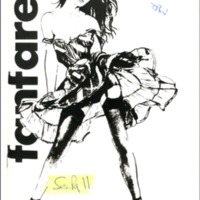Browse Exhibits (24 total)
Cookbooks of Ontario: A Century of Soup
Over a century ago, cookbooks were around in Ontario, but they were much different from today. Browse this collection to see different soup recipes from 1831 to 1935 from Toronto to Parry Sound. Take a read through these pages to learn more about soup in Ontario during the 19th and 20th centuries.
White Paper/Red Paper Exchange: Indigenous Resistance and Activism between the 1960s and 1980s
A discussion of the White Paper/Red Paper Exchange and how this impacted the emergence of Indigenous political and legal activism on a national scale within Canada and an international scale in the United States and parts of Europe, between the late 1960s and early 1980s.
University of Ottawa's Artist Book Collection
Welcome to the website dedicated to the University of Ottawa’s artist book collection! Here, you will be able to find all the information you need to understand what an artist book is, and what can be found in the University of Ottawa’s own special collection.
What is an artist book? Artist books are difficult to define because the concept of an artist book has evolved considerably over the years, which has led to a few self-conflicting characteristics and significant debate over what can be considered as an “artist book.”
According to the artist, art critic, and art theorist Johanna Drucker, an artist book is “any work of original art created in the book format." The Getty Research Institute adds to Drucker’s definition, and specifies that artist books include “commercial publications (usually in limited editions), as well as unique items formed or arranged by the artist.”
Drucker and the Getty Research Institute essentially define artist books as a medium, or the methods and materials used by artists to create artwork and express their ideas. As a medium, artist books have a different kind of agency than auction catalogues and textbooks on art, whose primary function is to convey information on pre-existing works. Instead, artist books are created to communicate a specific message, which can range from the development of their practice to a poignant social-political commentary.
In general, artist books follow the general book format and communicate their ideas with words and images on pages between two covers. However, like all artistic endeavours, there are exceptions to this rule, some of which can be found in the University of Ottawa’s collection. Like with other mediums, artists are relatively free in their choice of aesthetics (the materials and techniques used in the design and production of the book) and content (the themes, subjects and ideas communicated by the book).
American Women in Tobacco Advertisements 1929-1939
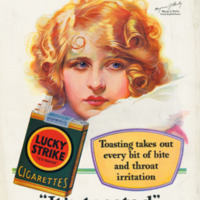
The research topic is centered on tobacco advertisements that were created by the American Tobacco Company between 1929-1939. The approach is focused on examining how Lucky Strike cigarettes were advertised to American women, and to determine the motives, efficiency, and shortcomings of the advertisements, as well as the different tactics that were deployed to enhance the female market during the Great Depression era. Primary sources that will be examined are Lucky Strike advertisements featuring and promoting the sale of tobacco to women. All advertisements can be found on the Stanford Research Institute website.
The purpose for using Omeka is ultimately to incorporate various advertisements on an interactive website, which allows for better engagement and analysis to be conducted, and it provides the public with further information concerning the selling of tobacco to women. The websites provides a platform focused on promoting the digitization of history more broadly.
The aim of the project is to identify the history of tobacco advertising, specifically the ones affiliated with American Tobacco Company. Specifically, the research will identify the advertisement mediums used to target women, as well as the general information regarding the advertising and the company. The Torches of Freedom campaign will be briefly examined. Furthermore, Lucky Strike used many different campaigns, which will be analyzed more broadly.
Lucky Strike Campaigns:
Lucky Strike used various campaigns to promote and sell tobacco to women, which can be broken down into three general categories: Weight and Slimness; Love and Femininity; and Fashion and Elitism. Each campaign sought to advertise nicotine products to American women by publicly endorsing female smokers, and promoting cigarettes as symbols of emancipation. The purpose was to increase the American Tobacco Company’s profitability by pushing for higher numbers of female consumers, leading to an upsurge in Lucky Strike’s market share.
Weight and Slimness:
The campaign was organized under the American Tobacco Company and promoted by Lucky Strike cigarettes, specifically focusing on weight loss, slimness, and avoiding overindulgence or temptation. The slogans that were used include: “Reach for a Lucky,” “Future Shadow Faces,” and “Tempted to Over-Indulge.”
Love and Femininity:
The campaign was headed by the American Tobacco Company and promoted by Lucky Strike cigarettes, and it pertained to various themes relating to health, feminine imagery, love and tradition. Slogans that were used include: “Sunshine Mellows,” and “Couples in Love.”
Fashion and Elitism:
The campaign was led by the American Tobacco Company and promoted by Lucky Strike cigarettes, particularly centered on the elite and upper-class American women, specifically using celebrity endorsements and fashionable imagery to promote the product. Various slogans that were used include: “Your Adams Apple,” “It’s Toasted,” “Cream of Crop,” and “High Fashion.”
Car Advertisements in Windsor Ontario 1928-1958
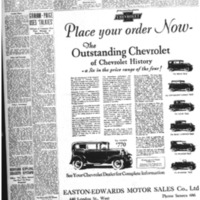
This collection analyzes car advertisements from Windsor, Ontario from 1928-1958 every ten years. I analyze the advertisements through brand, material, depiction, selling point, and value. I chose these specific advertisements because of the use of gendered language and expectation on the reader. The primary sources offer an insight into the different societal expectations of men and women within a different context. This context is not so far removed from contemporary society, and it is important to understand the evolution of gender expectations and stereotypies.
In order to extrapolate the most elements of the advertisements, I am ultimately tracking the change over time of the advertisements and if these advertisements are becoming more gender specific. Analyzing history within a gendered lens is useful in order to gain a deeper understanding of societal context in a time when gendered expectations were much more prominent, clear, and distinct. By focusing on the depiction of women through the advertisements, I can gain some insight into how the producer engineered their advertisements towards men and women. There are of course limitations to my sources as they only portray depictions of gender expectations from the producer’s perspective and not the consumer.
Initially, I started out with the years 1928-1968, but I then changed the years from 1928/1929, 1938/1939, 1948/1949, 1959/1960. I begin in 1928 because that is the earliest date that the microfilm begins, and going consecutively every ten years up until 1948/1949 bypasses global events that may have taken precedent over other advertisements such as the depression and Second World War. Up until 1948/1959 I analyze microfilm from the Library and Archives Canada. After that year, I used Google Archives as it was easier to use but only begins in 1959 as opposed to 1958. That is the reason why I end with 1959/1960, but no major event happened between 1958 and 1959 and the 1959/1960 ads are still relevant and worth examining.
For value, only the ones in 1928 and 1938 actually say the price of the car, so past those years I don’t have the prices for the cars. Function describes the ad and how its selling itself, whether it be on safety features, middle class affordability, aesthetics, comfort, dependability, or modernity.
I define ‘modernity’ as ‘the next-best-thing’. Many advertisements who use this kind of jargon emphasize the latest technology, the newness of the car, and the advanced features. Similar to ‘luxury’ in that it may promote the envy of others, ‘modernity’ is associated with newness and distinctly ‘modern’.
There were some cars in the later years which emphasized ‘Middle class affordability’. This mentality described how affordable the car was to almost everyone, and so the ease of accessibility and the first waves of mass consumption post-war can be associated with the raising incomes. The ‘material’ emphasis how the ad describes the car. Most of them are based on quality-price value which I define as ‘getting more for your dollar’, some of them are aesthetics of the car and engine models, and a small minority are nationalistic.
The initial phases of my research found that most ads were fairly gender neutral. I define ‘gender neutral’ from a male lens since the target and expected audience would be the men unless clearly a woman is clearly depicted or “speaking” in the advertisement. 1948/9-1959/60 tend to favour ‘quality-price-value’ and ‘safety’ as their selling points. While the description of the car goes from one of luxury to one of accessibility for all, the distinctions made between genders becomes increasingly prominent by the 1959/60 advertisements.
Montreal & the Irish
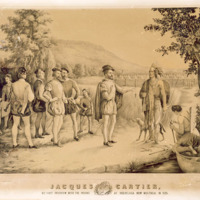
As the city of Montreal celebrates its 375th anniversary, it is important to both look back and reflect on the city’s long and storied history. From its simple beginnings as a ‘trading post’, Montreal has developed into one of Canada’s largest cities. Throughout the city’s transformation, there has almost always been a strong Irish community and presence within the city. The purpose of this site is to demonstrate the history of the city of Montreal in relation to “the role of the Irish immigrants as one of the five founding peoples” of Montreal. Through the demonstration of my research, I hope to paint a picture of the Irish community in Montreal between the sixteenth and the twenty-first century. In order to properly to do to this, this site will begin with a quick contextualization of the development of the the city of Montreal in relation to people of Ireland and their descendants. This will lead me into an analysis of the growth of both the city and its Irish population, as well as a recognition of the factors which contributed to the high influxes of Irish immigrants. I will then describe the social climate in Montreal between the end of the 19th century as it developed into what it is today. I will conclude by exploring the relationship of the established Irish community and the rest of the city. I hope to demonstrate the overall development of the Irish community in Montreal. While the relationship between the Irish and the rest of Montreal has not always been as friendly as it is today, I will be focusing on the positive aspects associated with the development of the Irish community in Montreal.
Nothing But Realism: Radio and Country Music Across America, 1920-1960
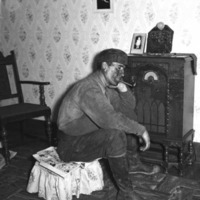
This exhibit explores the connection between radio and country music, especially related to radio's role in expanding the genre's audience beyond its Southern roots.

